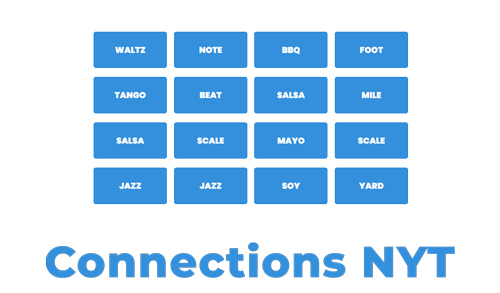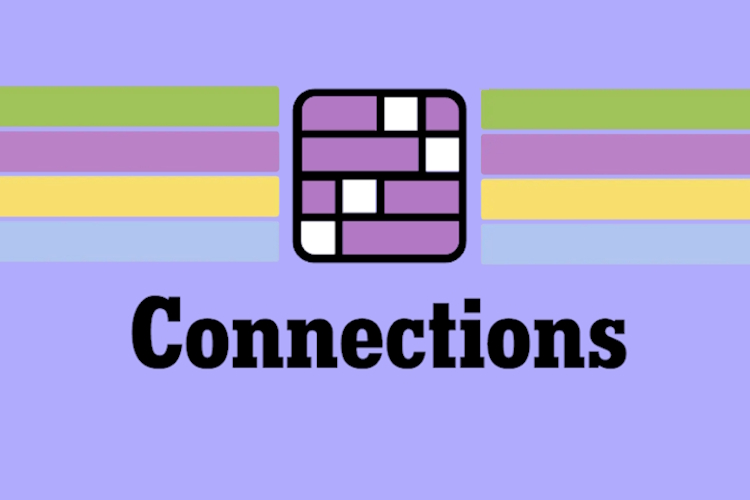NYT Connections is a daily word association game published by the New York Times. It’s similar to Wordle in that it’s a quick, daily puzzle that can be completed in a few minutes, but instead of guessing a single five-letter word, you need to categorize 16 words into four groups based on a hidden thematic connection.
Simple Words “The NYT‘s latest daily word game has become a social media hit. The Times credits associate puzzle editor Wyna Liu with helping to create the new word game and bringing it to the publications’ Games section. Connections can be played on both web browsers and mobile devices and require players to group four words that share something in common.”

How To Play Connections
In Connections, you’re presented with a grid of 16 words. Your task is to arrange them into four groups of four by figuring out the links between them. The groups could be things like horror movie franchises, a type of verb or rappers.
There’s only one solution for each puzzle, and you’ll need to be careful when it comes to words that might fit into more than one category. You can shuffle the words to perhaps help you see links between them.
“Connections” is a word association game where players take turns saying words that are related to the previous word. The goal is to create a chain of connected words. Here’s a simple guide on how to play:
Number of Players: Connections can be played with two or more players.
Setup: Choose a starting player. This player will say the first word to kick off the game.
Gameplay:
- The starting player says a word out loud. This word can be anything.
- The next player must then say a word that is somehow related to the previous word. The relationship can be based on similarities, associations, opposites, or any creative connection.
- The game continues with each player saying a word that connects to the previous word in some way.
Rules:
- Words should be spoken relatively quickly; there’s usually a time limit (e.g., 5-10 seconds) for each player’s turn to keep the game moving.
- A player is eliminated if they can’t think of a relevant word within the time limit or if they repeat a word that has already been used in the current round.
Variations:
- Category Connections: Players can decide on a category before starting the game, and each word must fall within that category (e.g., animals, movies, countries).
- Alphabetical Connections: Words must start with the same letter as the previous word. For added difficulty, use a specific order (e.g., A, B, C) or reverse order (e.g., Z, Y, X).
- Story Connections: Players create a collaborative story by connecting words. Each word should somehow link to the previous one, forming a narrative.
Winning: The game can be played for a set number of rounds or until only one player remains. The last person standing is the winner.
Connections is a flexible and creative game that can be adapted to suit the preferences of the players. It encourages quick thinking, creativity, and linguistic associations.
Hints for today’s Connections
We can help you solve today’s Connection by telling you the four themes. If you need more assistance, we’ll also give you one word from each group below.
Today’s themes
- Grocery store aisles
- Encourage, with “on”
- Spherical foods
- Go ___
One-answer reveals
- Grocery store aisles – Dairy
- Encourage, with “on” – Egg
- Spherical foods – Jawbreaker
- Go ___ – Bananas

Today’s Connections answers
Still no luck? That’s OK. This puzzle is designed to be difficult. If you just want to see today’s Connections answer, we’ve got you covered below:
- Grocery store aisles – Dairy, Frozen, Produce, Snack
- Encourage, with “on” – Egg, Goad, Spur, Urge
- Spherical foods – Jawbreaker, Meatball, Mozzarella, Orange
- Go ___ – Bananas, Figure, Fish, Steady
Explore Alternative Puzzle Games
The New York Times offers a variety of puzzle games that are popular and have been enjoyed by readers. Here are some of them:
- Crossword Puzzles: The New York Times crossword puzzles are famous for their quality and difficulty. They offer daily and Sunday puzzles, with increasing levels of challenge throughout the week.
- Sudoku: Sudoku puzzles are number-placement games that involve filling a 9×9 grid so that each column, each row, and each of the nine 3×3 subgrids contain all of the digits from 1 to 9.
- KenKen: This is a grid-based puzzle game that combines elements of Sudoku and arithmetic. The goal is to fill the grid with numbers while adhering to certain rules and arithmetic clues.
- Spelling Bee: In this word game, players try to create as many words as possible using a specific set of letters, with one letter designated as the central letter.
- The Mini Crossword: A smaller version of the classic crossword, the mini crossword is a quick and fun puzzle that can be solved in a few minutes.
- Letter Boxed: In this game, players must create words using a set of letters, and the challenge is to connect the last letter of one word to the first letter of the next word.
Focus on a Specific Aspect of NYT Connections
- NYT Connections, the beloved word association game, delved into our ability to connect ideas, using word association to navigate the intricate pathways of our brains. Each puzzle became a mini-mystery, releasing dopamine with every “aha!” moment and fueling the motivation to keep playing.
- Beyond recognizing associations, solving the game required critical thinking, and engaging various cognitive domains in a mental workout. The dance of language and culture added depth, demanding an understanding of subtle nuances and cultural references. The game’s individualized experience, shaped by personal knowledge and background, fostered replayability and a sense of community.
- While the game is no more, its legacy endures, teaching us about language’s power, the thrill of discovery, and the joy of mental stimulation. So, in facing a word association challenge, recall the hidden connections that made NYT Connections captivating.
- The psychology behind word association: Explore the cognitive processes involved in grouping words and the satisfaction of solving puzzles.
- The role of language and culture in word games: Discuss how language nuances and cultural references can influence the difficulty and enjoyment of wordplay.
- Data analysis of NYT Connections puzzles: Analyze past puzzles to identify patterns, common themes, and interesting statistics.
Frequently Asked Question
SMH stands for “Shaking My Head.”
It’s commonly used to express disbelief, disappointment, or disapproval. For example, “That was a silly mistake, SMH.”
SMH is informal and is typically used in casual conversations, especially in text messages, social media, or online forums.
Yes, similar expressions include “facepalm,” “headshake,” or “sigh.” Each conveys a sense of disbelief or frustration.




















